Director General’s foreword
As we rapidly approach the end of what has been a productive 2015, it is time again to welcome readers to the final edition of the DG's eNews for the year.
In this edition we take a look at some of the latest figures compiled by my department from the 2014-2015 financial year.
Despite many challenges for the Western Australian resources sector, the value of our mineral and petroleum industry was $99.5 billion, largely the result of a weaker iron ore price.
Recently I returned from a two-city tour to China to promote investment opportunities in our resources sector, telling investors that the down turn in equity markets provided an opportunity for new investment.
At the end of August, members of the department’s Corporate Executive spent four days visiting resource and infrastructure projects in the Kimberley, allowing the group to gain a ‘bigger picture’ view of how the resources industry fits into the State Government’s agenda.
Department staff travelled extensively throughout the State during the year to answer questions from the community and other stakeholders regarding the State Government’s regulation of the shale and tight gas industry.
Most of the community interest revolved around land access and compensation, environmental impacts to water, flora and fauna and what constitutes best practice regulation.
In this edition we also take a look at the department’s revised three-year strategic plan, which has made stakeholder engagement a priority.
Just as resource companies must earn their social licence to operate in Western Australia, DMP needs to maintain community and stakeholder confidence in our regulation of industry.
WA’s emerging oil, shale and tight gas sector was also put under the spotlight at DMP’s annual Petroleum and Geothermal Open Day, along with the latest acreage release for areas within the onshore Canning Basin and State waters in the Northern Carnarvon Basin.
My department continues to reaffirm its commitment to safety with the recent release of a report which improves our understanding of what causes serious accidents.
The report will also help prevent serious accidents having fatal outcomes.
The DG’s eNews is a valuable tool for anyone interested in the future of the Western Australian mining and petroleum industry. It provides updates on the latest activities of the department, so please recommend it to your colleagues.
Richard Sellers
Director General
Department of Mines and Petroleum
Director General promotes WA resources industry to Chinese investors
Department 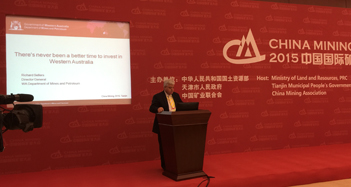 of Mines and Petroleum (DMP) Director General Richard Sellers returned recently from a two-city tour of China to promote investment opportunities in Western Australia’s resources sector.
of Mines and Petroleum (DMP) Director General Richard Sellers returned recently from a two-city tour of China to promote investment opportunities in Western Australia’s resources sector.
As a keynote speaker at the Minerals Investment Seminar in Beijing, Mr Sellers promoted gold prospectivity in the State, citing eight new discoveries in 2014-15.
“There is plenty of potential for gold exploration and Western Australia accounts for more than half of the 1,520 gold exploration and mining projects in Australia, including gold by-products,” Mr Sellers said.
He told investors in the Chinese capital that the downturn in equity markets provided an opportunity for new investment.
“The current economic environment provides for major cost cutting with less competition for labour, lower wages, and less competition for service companies leading to lower operating and capital costs, along with keen sellers,” the Director General said.
“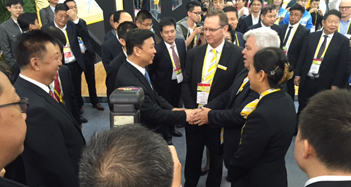 While times are tough this provides investment opportunities and most Western Australian deposits are mined at the lower end of the gold cost curve.”
While times are tough this provides investment opportunities and most Western Australian deposits are mined at the lower end of the gold cost curve.”
Mr Sellers also addressed investors at the China Mining Congress and Expo 2015 in Tianjin, telling those in attendance there had never been a better time to invest in Western Australia.
“There are many licence holders looking for joint venture partners, with many companies wanting equity which are providing opportunities at all development stages, including off-take agreements,” he said.
Mr Sellers reminded investors that under the Fraser Institute’s world rankings, WA was among the top-rated jurisdictions for investment attractiveness in 2014 and was ranked fifth in the world for the quality of its geoscience databases.
“In fact there were 33 new mineral discoveries made in WA in the last year, largely gold, copper, nickel and heavy mineral sands,” he said.
Mr Sellers said it was important to promote investment opportunities overseas and that China was already a big investor in the State’s resources industry, including the uranium exploration sector.
There are currently more than 120 significant mining and exploration projects in WA with Chinese investment.
“The majority of mining investments have been successful, and the clear message to the Chinese was that now is an excellent time to invest, especially in light of the removal of the Mineral Resources Rent Tax and Carbon Tax, the introduction of the Commonwealth Exploration Development Initiative, the continuation of the Exploration Incentive Scheme (EIS), and deferring of changes to royalty rates,” Mr Sellers said.
The Director General’s latest investment drive follows a 10-day trade mission to Singapore, South Korea and China in May with Mines and Petroleum Minister Bill Marmion.
DMP’s Corporate Executive visit Kimberley
At the end of August, members of the  Department of Mines and Petroleum’s (DMP) Corporate Executive spent four days visiting resource and infrastructure projects in the Kimberley.
Department of Mines and Petroleum’s (DMP) Corporate Executive spent four days visiting resource and infrastructure projects in the Kimberley.
DMP Director General Richard Sellers said the visit allowed the Corporate Executive to gain a ‘bigger picture’ view of how the resources industry fitted into the Western Australian Government agenda.
“Site visits assist us in developing relationships and gaining a greater understanding of their business, including their challenges and successes,” Mr Sellers said.
In Broome, the group visited the Kimberley Ports Authority and the International Airport before a trip to Buru Energy’s Praslin drill site and the company’s Ungani site.
“Buru’s 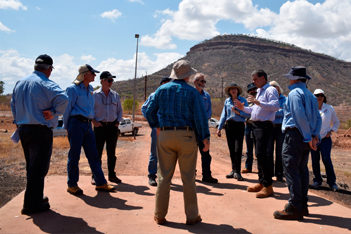 conventional oil discovery at Ungani in 2011 was the first onshore oil discovery in Western Australia in 10 years,” Mr Sellers said.
conventional oil discovery at Ungani in 2011 was the first onshore oil discovery in Western Australia in 10 years,” Mr Sellers said.
“The field was currently producing 1,250 barrels of oil per day during our visit. It is then exported by road train to Wyndham, where it is loaded onto a crude carrier ship for sale to South East Asian refineries.”
If petroleum prices improve and production reached a sustainable 5,000 barrels per day, construction of a pipeline to Broome could be economically feasible.
The Buru visit was followed by a trip to Sheffield Resources’ Thunderbird project site.
“While the Thunderbird Mineral Sands project is still several years away from production, 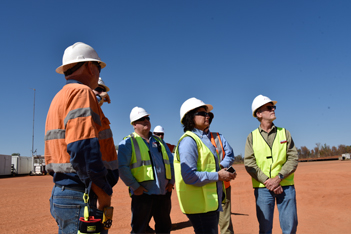 the site visit was a great opportunity to get a look at the operation in the early stages,” Mr Sellers said.
the site visit was a great opportunity to get a look at the operation in the early stages,” Mr Sellers said.
“Thunderbird is the first major mineral sand deposition discovery in the Canning Basin and with few major new zircon projects in the global development pipeline, the project is well placed to meet future demand.
“If technical and economic feasibility is established, both the Buru and Sheffield resource projects will be the basis of ongoing income and employment in the West Kimberley.”
Next on the itinerary was a visit to the Wyndham Port Offices. This was followed by a drive to Ivanhoe Crossing, which is expected to reopen sometime in the future, and has become a popular tourist destination.
While 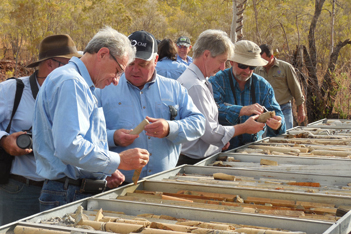 in Broome and Kununurra the Corporate Executive met with other State and Federal Departments, Aboriginal groups, the Kimberley Training Institute, Regional Development Australia, and Broome Future Limited.
in Broome and Kununurra the Corporate Executive met with other State and Federal Departments, Aboriginal groups, the Kimberley Training Institute, Regional Development Australia, and Broome Future Limited.
“It is important for members of the Corporate Executive to visit regional areas to get a perspective of the issues and some of the challenges faced in isolated areas,” Mr Sellers said.
“Networking events with relevant government staff, businesses and local government representatives also provide opportunities to build relationships.”
Mr Sellers said feedback from shire officials and business leaders in Broome showed strong support for resource development in general.
“There 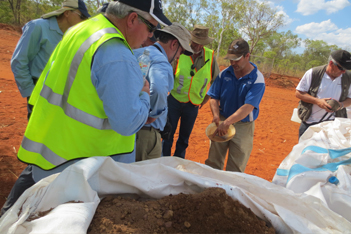 is strong support for the concept of Broome growing as a logistics hub for the Browse Basin.”
is strong support for the concept of Broome growing as a logistics hub for the Browse Basin.”
He said the ease of access from Broome to the offshore Browse Basin also provided the Port of Broome with the opportunity to capitalise on oil and gas developments by companies such as Inpex, Shell, Woodside Petroleum and ConocoPhillips, through the provision of fuel and building businesses to support operations, including Floating Liquefied Natural Gas (FLNG).
“The development of a marine supply base precinct adjacent to the Port is identified as a priority under the Western Australian Regional Freight Transport Network Plan,” Mr Sellers said.
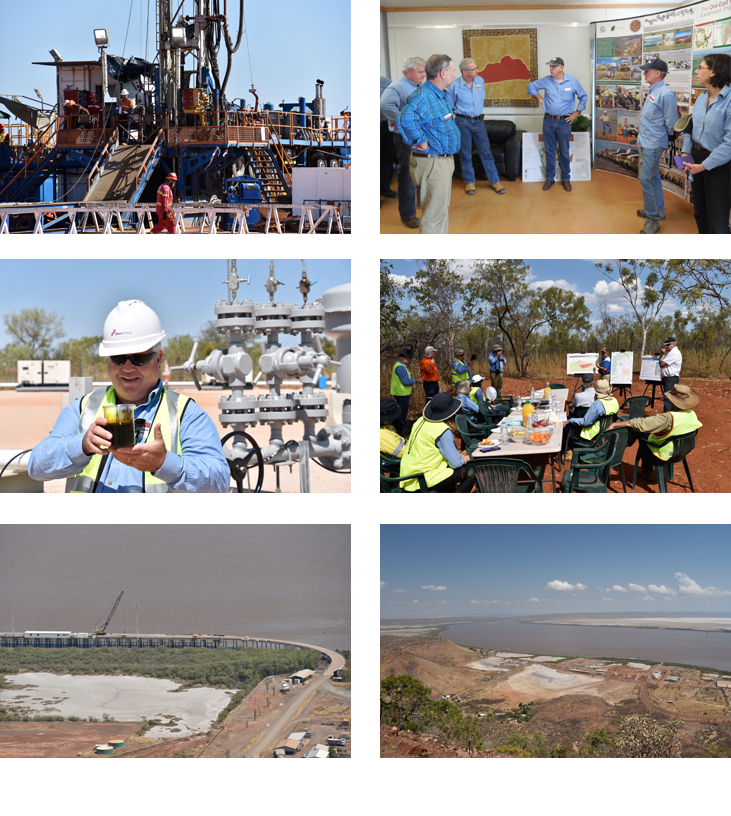
DMP staff attend Statewide information sessions
Department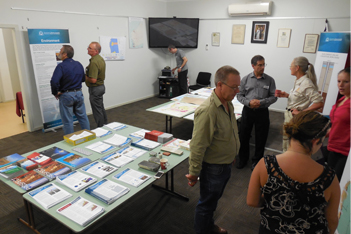 of Mines and Petroleum (DMP) Director General Richard Sellers has congratulated Petroleum, Environment and Stakeholder Engagement staff on their efforts to address community and other stakeholders queries and concerns about the State Government’s regulation of the shale and tight gas industry.
of Mines and Petroleum (DMP) Director General Richard Sellers has congratulated Petroleum, Environment and Stakeholder Engagement staff on their efforts to address community and other stakeholders queries and concerns about the State Government’s regulation of the shale and tight gas industry.
DMP staff held a stall at the two-day MidWest Expo at Mingenew and a booth at the Irwin Shire Onshore Energy Community Information Day at Port Denison during September.
At Mingenew most of the community interest revolved around land access and compensation, environmental impacts to water, flora and fauna and what constitutes best practice regulation.
The department’s 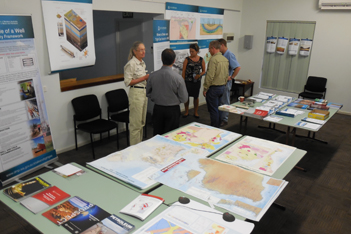 attendance at the Port Denison event followed a request from the Shire of Irwin to host a community information day that would be attended by relevant government agencies, industry groups and community organisations.
attendance at the Port Denison event followed a request from the Shire of Irwin to host a community information day that would be attended by relevant government agencies, industry groups and community organisations.
Mr Sellers said there had been a number of enquiries from community members regarding news of a potential change in local gas activities and that the shire had decided to hold the information day to raise community awareness of future gas drilling operations.
The day was also attended by representatives from a number of petroleum companies, the Australian Petroleum Production and Exploration Association (APPEA), Department of Water, Commonwealth Scientific and Industrial Research Organisation (CSIRO)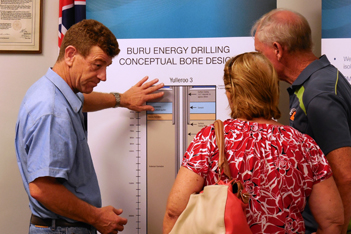 , Conservation Council of WA, and a number of other conservation non-government organisations (NGOs).
, Conservation Council of WA, and a number of other conservation non-government organisations (NGOs).
“The fact that the day was attended by such a diverse group allowed members of the public to be informed of a range of views and compare facts from a range of experts,” Mr Sellers said.
In July, DMP staff also briefed local government and local Members of Parliament in the Cities of Bunbury and Busselton and the shires of Dardanup, Capel and Donnybrook/Balingup on a potential exploration area located south and east of Bunbury.
Senior DMP staff visited Bunbury in November, holding a lunch forum with local government and industry.
Representatives 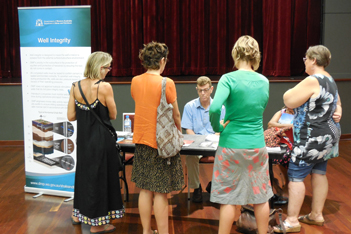 were told that the company involved, Bunbury Energy Pty Ltd, was still progressing its native title negotiations and is required to provide DMP with a detailed stakeholder engagement plan before the end of November, 2015.
were told that the company involved, Bunbury Energy Pty Ltd, was still progressing its native title negotiations and is required to provide DMP with a detailed stakeholder engagement plan before the end of November, 2015.
“No exploration activity can begin until the company has been granted an exploration permit and all relevant approvals have been provided,” Mr Sellers said.
In June DMP specialists participated in a two-day seminar on water management for shale and tight gas exploration and production.
Leading international petroleum industry professionals and scientists attended the seminar in Perth to share their experiences from around the world.
Department of 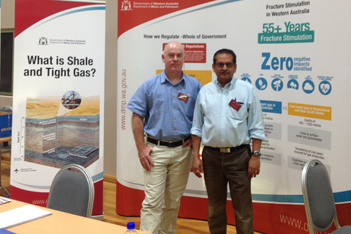 Water representatives also participated in the event, which was organised by the WA branches of the International Association of Hydrogeologists, Society of Petroleum Engineers and the Australian Society of Exploration Geophysicists.
Water representatives also participated in the event, which was organised by the WA branches of the International Association of Hydrogeologists, Society of Petroleum Engineers and the Australian Society of Exploration Geophysicists.
Mr Sellers said he was impressed by the line-up of speakers and the range of topics being addressed.
“This is a gathering of minds in the areas of hydrogeology, geophysics and engineering that is focused on protecting Western Australia’s groundwater,” he said.
In May DMP staff travelled to the Love Broome Expo to answer similar questions from the community, as a follow-up to earlier community information sessions held in Broome and Derby in March.
Information meetings were also held with the Nyangumarta People and members of the North West Environmental Health Officer Group.
Many of the community members who attended the Expo expressed a keen interest in the resources sector, with more than 70 people having face-to-face discussions with staff to gain more information.
Mr Sellers said it was important to increase community awareness and knowledge of Western Australia’s geology and technological advancements in oil and gas extraction.
“The department urges the oil and gas industry to engage early and keep the local community informed of their activities throughout the life of their projects,” he said.
The main areas of interest from community members were the design and long-term integrity of wells, land access, use of chemicals and protection of aquifers, and accountability and transparency of the approvals processes.
Strategically planning Western Australia’s resources future
The Department 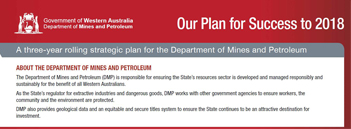 of Mines and Petroleum (DMP) has prioritised stakeholder engagement in its revised three-year strategic plan.
of Mines and Petroleum (DMP) has prioritised stakeholder engagement in its revised three-year strategic plan.
DMP Director General Richard Sellers said the department is committed to facilitating sustainable resources sector development and responsible operations management for the long-term benefit of Western Australia.
“The department reviews the strategic plan annually and adjusts its focus to align with changes in the resources sector and community expectations around responsible resources development,” Mr Sellers said.
“Just as resource companies must earn their social licence to successfully operate in Western Australia, DMP needs to maintain community and stakeholder confidence in our regulation of industry.
“Building relationships and consulting early will be key to maintaining trust and confidence in DMP.
“With increasing levels of community interest in resource projects, particularly in relation to environmental and land access issues, we involve all stakeholders when developing new policies and programs across all business areas.”
Stakeholder Engagement Working Group
DMP has also established an in-house Stakeholder Engagement Working Group to help coordinate stakeholder engagement activities across its business areas.
The working group is developing initiatives to better communicate stakeholder engagement activities across the department to streamline these activities and make the engagement more effective.
This 15-member working group is made up of staff representing all DMP business areas.
The group is also working on initiatives to build on established stakeholder relationships and provide input and guidance into internal and external stakeholder engagement plans and strategies.
DMP’s strategic plan, titled ‘Our Plan for Success to 2018’, is part of the department’s planning framework and represents a three-year rolling plan of strategies across all business areas.
The 2015-18 Strategic Plan is now available on the DMP website
DMP commitment to engage with community and industry stakeholders
As part of the Department 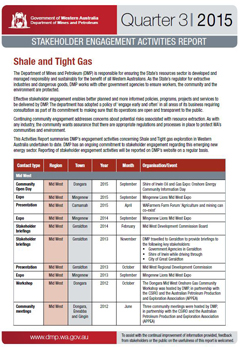 of Mines and Petroleum’s (DMP) commitment to engage with community and industry stakeholders, quarterly Stakeholder Engagement Activity Reports will be published on its website.
of Mines and Petroleum’s (DMP) commitment to engage with community and industry stakeholders, quarterly Stakeholder Engagement Activity Reports will be published on its website.
The quarterly reports will provide a summary of the department’s engagement activities undertaken to date in relation to shale and tight gas exploration in Western Australia.
“DMP has an ongoing commitment to stakeholder engagement regarding this emerging new energy sector, and engagement activities will be reported on the department’s website on a regular basis,” DMP Director General Richard Sellers said.
He said that continuing community engagement addresses concerns about potential risks associated with resource extraction.
“As with any industry, the community wants assurances there are appropriate regulations and processes in place to protect WA’s communities and the environment,” Mr Sellers said.
“DMP has adopted a policy of ‘engage early and often’ in all areas of our business and we are committed to making sure that our operations are open and transparent to the public.”
DMP has prioritised stakeholder engagement in its revised three-year strategic plan.
“The department reviews the strategic plan annually and adjusts its focus to align with changes in the resources sector and community expectations around responsible resources development,” Mr Sellers said.
With new regulations in place, there is now a requirement for industry to undertake timely, open and ongoing engagement with all stakeholders throughout the life of a project.
During the past year departmental staff have held public information sessions in the Kimberley, Pilbara, Gascoyne, Mid West, Perth metropolitan area and the South West.
This includes meetings with local government representatives, Aboriginal groups, port authorities, State Government agencies, Regional Chambers of Commerce and Industry, farmers groups, Development Commissions and non-governmental organisations.
Stakeholder Engagement Activities Reports can found at www.dmp.wa.gov.au.
Regulatory framework to guide future development of shale and tight gas
Western Australia’s 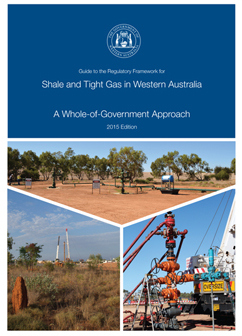 whole-of-government regulatory framework for shale and tight gas has been outlined in a document prepared by DMP in collaboration with government agencies charged with assessing and regulating petroleum resources.
whole-of-government regulatory framework for shale and tight gas has been outlined in a document prepared by DMP in collaboration with government agencies charged with assessing and regulating petroleum resources.
The framework document was coordinated by the Department of Mines and Petroleum (DMP), the lead agency for regulating the resources sector in Western Australia.
“The framework will assist industry, other stakeholders and the public with information regarding the State’s robust regulatory assessment, approval and compliance processes for shale and tight gas projects as well as other petroleum projects,” DMP Director General Richard Sellers said.
The ‘Guide to the Regulatory Framework for Shale and Tight Gas in Western Australia’ has been endorsed by the Environmental Protection Authority, Office of the Environmental Protection Authority, and the Departments of Water, Health, Environment Regulation, Aboriginal Affairs, Parks and Wildlife, and Planning.
Mr Sellers said the multi-agency collaborative approach was a key element in the development of the State’s petroleum resources.
He also said agencies are united by a common and overarching responsibility to manage risk, whether to the natural environment, human health or the amenity of communities.
Department of Water spokesperson Executive Director Policy and Innovation Tad Bagdon said the early consideration of water related issues in the assessment process had been a significant achievement of the framework development, in line with public expectations.
“The Department of Water’s advice on water is used by DMP and the Environmental Protection Authority to determine what level of environmental assessment is needed on each proposal.
“By building in processes for early and sufficient consideration, the Department of Water makes sure that enough scientific information is available about risks to water resources before decisions are made.”
New regulations for the petroleum and geothermal industries that came into effect on 1 July 2015 are now the most stringent in Australia.
The regulatory framework sets out the requirements and expectations of the State Government and covers the need for industry to consult and engage with the community in a timely and ongoing manner throughout the life of a project.
WA’s shale and tight gas industry is currently in the early stages of exploration, with any significant commercial production predicted to be about five to ten years away.
“However, it is important that there is clarity for industry and the public about the States’ expectations and the legislation and regulations through which these expectations are enforced,” Mr Sellers said.
The document is available on the DMP website.
New award recognises resources sector and community partnerships
A new resources 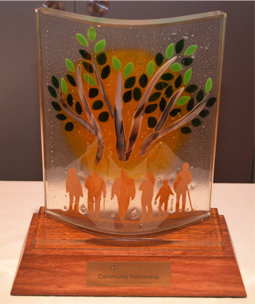 sector award recognising outstanding achievement and leadership by companies in building meaningful community partnerships has been launched by the Department of Mines and Petroleum (DMP).
sector award recognising outstanding achievement and leadership by companies in building meaningful community partnerships has been launched by the Department of Mines and Petroleum (DMP).
Director General Richard Sellers said DMP will present the inaugural Community Partnership Award for Excellence in 2016.
“The Community Partnership Award will recognise resources companies and communities which demonstrate strong leadership in building meaningful partnerships to achieve positive outcomes,” Mr Sellers said.
He said the department had prioritised stakeholder engagement in its recently revised three-year strategic plan, and expected resources companies to engage with communities as well to gain a social licence to operate.
“Gaining a social licence is now critical to the success or failure of any resource operation in Australia,” Mr Sellers said.
“There is an increasing level of community interest in resource projects, particularly in relation to environmental and land access issues, and community engagement is essential to build confidence in the responsible development of the State’s resources.
“This award will help build the reputation of Western Australian resources companies that are raising the bar and setting new benchmarks in community consultation and partnerships.”
Any company or individual operating within Western Australia’s minerals, energy resources or extractive industries is encouraged to nominate a project for the Community Partnership Award.
The assessment criteria will be made available on the DMP website when nominations open on 1 February 2016.
Mines and Petroleum Minister Bill Marmion launched the new award last month at the 2015 Golden Gecko Awards for Environmental Excellence
"Resources companies are expected to be good corporate citizens who engage in a meaningful and ongoing capacity with all stakeholders including communities,” Mr Marmion said.
"By engaging with communities and community groups to understand their concerns, resources companies can help leave an ongoing positive legacy in the communities where they operate."
Visit the Community Partnership Award page on the DMP website or email communitypartnerships@dmp.wa.gov.au for more information about the new award.
Perth Basin shale and tight gas baseline monitoring project
A two-year 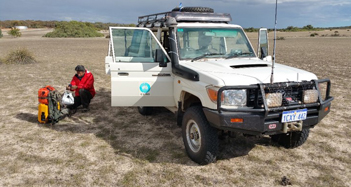 baseline monitoring project is set to become part of the Perth Basin Shale and Tight Gas Monitoring Joint Industry Program.
baseline monitoring project is set to become part of the Perth Basin Shale and Tight Gas Monitoring Joint Industry Program.
Department of Mines and Petroleum (DMP) Director General Richard Sellers said the program would help improve our understanding of suitable methods and protocols for establishing environmental baselines associated with shale and tight gas development.
The project ‘Baseline Characterisation and Monitoring Protocols for Development of Shale and Tight Gas Resources, Perth Basin’ will include the identification of vulnerable environment aspects to more effectively target monitoring for potential impact.
“It will focus on techniques for establishing baseline values of methane in near-surface, surface and shallow-subsurface environments of the Perth Basin and micro-seismic activities in the deep sub-surface,” Mr Sellers said.
The baseline project will be carried out by the Commonwealth Scientific and Industrial Research Organisation (CSIRO) in collaboration with the University of Western Australia.
Mr Sellers said he was pleased the department was a project sponsor along with four oil and gas operators in the mid-west (AWE, Origin, Norwest Energy and Transerv Energy).
“DMP will also participate in the project as an advisory committee member to ensure it aligns with the goals of the monitoring program to study potential environmental impacts of onshore gas development in the Perth Basin,” he said.
The Department of Water is on the advisory committee as an observer to ensure the water science is accurate, available and applied appropriately to enhance the government’s water resource management goals.
The CSIRO will provide the sponsors with the interim reports and data of specific studies as they are finalised.
The project will also develop a GIS based database containing all monitoring data and geological information obtained as part of the study, along with a comprehensive report analysing the data obtained from groundwater, soil gas, atmosphere and micro-seismic measurements.
Figure 1. The four environmental domains under consideration in this program.
Further information: Dr Sunil Varma (sunil.varma@dmp.wa.gov.au) or 08 9222 3267
DMP increases environmental compliance investigations
An 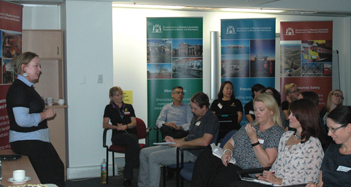 increase in compliance investigations by the Department of Mines and Petroleum (DMP) has revealed a ‘reassuring’ level of law abidance by Western Australian mining operators.
increase in compliance investigations by the Department of Mines and Petroleum (DMP) has revealed a ‘reassuring’ level of law abidance by Western Australian mining operators.
Director General Richard Sellers said the department’s Environment Division had boosted its number of compliance investigations by 200 per cent in 2014-15, compared to the previous financial year.
“Compliance investigations included reviews of Annual Environmental Reports, desktop site audits and Mining Rehabilitation Fund audits, as well as onsite inspections,” Mr Sellers said.
He said that while a stable level of environmental compliance in the industry was reassuring, industry and government both needed to remain vigilant.
The increase in recent compliance activity comes from a shift in the division’s focus to risk-based assessment and increased compliance monitoring to ensure industry business systems and risks to the environment are being well managed.
Mr Sellers said the introduction of Mining Proposal reform will further enhance the department’s capacity to increase its compliance and provide assurance to the community that the mining industry is meeting the community’s expectations.
The change in focus is part of the Reforming Environmental Regulation (RER) program DMP has been implementing since 2013.
“The Environment Division has also appointed and trained more inspectors and has adopted new technology to assist with compliance intelligence to help determine the risk profile for mine sites,” Mr Sellers said.
“This also allows the division to prioritise its resources to reduce any risks to the environment.”
Since RER was introduced, assessment timeframes for a number of environmental applications undertaken by the department have significantly reduced, as have the number of applications being rejected or withdrawn.
Stakeholder engagement
Throughout 2015, the Environment Division has also regularly engaged with a broad range of stakeholders to ensure decisions are made transparently and stakeholder interests are taken into account.
“Stakeholder engagement is vital for the successful development of environmental policy, and the division works very closely with a number of advisory groups including the Mining Industry Liaison Committee, Reforming Environmental Regulation Advisory Panel, and the Mining Rehabilitation Advisory Panel when developing policy and guidance material,” Mr Sellers said.
These groups include government and industry body representatives as well as community and conservation groups, which provide advice to the department on matters within their jurisdiction.
In addition, Environmental Division officers regularly meet to discuss specific issues and concerns with members of industry peak bodies such as the Chamber of Minerals and Energy WA (CMEWA), the Association of Mining and Exploration Companies (AMEC) and the Amalgamated Prospectors and Leaseholders Association (APLA).
Other environmental initiatives which have involved broad consultation with a range of stakeholders include the Mining Proposal reform, improvements to the Mining Rehabilitation Fund (MRF) online reporting system, proposed low-impact notification changes and the Pilbara Rehabilitation Project.
Mr Sellers said all complex guidelines released by the Environment Division undergo between four and eight weeks of consultation where public feedback is received and responded to, and amendments are made to the documents to improve useability.
All feedback received is published on the DMP website, along with the department’s responses and the actions taken.
Reforming Environmental Regulation program enters final stage
Industry 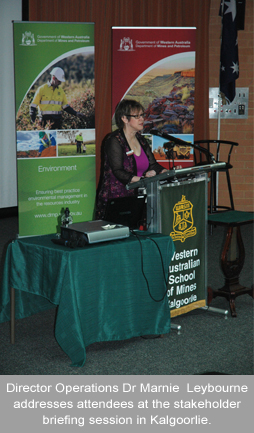 briefing sessions providing updates on Mining Proposal reform, the abandoned mines strategy, and the final stages of the RER program were held during November by the Department of Mines and Petroleum (DMP).
briefing sessions providing updates on Mining Proposal reform, the abandoned mines strategy, and the final stages of the RER program were held during November by the Department of Mines and Petroleum (DMP).
DMP’s Environment Division co-ordinated briefing sessions in Perth and Kalgoorlie as part of ongoing stakeholder engagement.
Both sessions were well attended by more than 200 industry stakeholders over the two days.
DMP Director General Richard Sellers said stakeholder engagement initiatives such as these helped deliver streamlined regulatory processes that benefit industry and government, and better environmental outcomes.
“The department is committed to the responsible development of resources in Western Australia,” Mr Sellers said.
“This means we need to work with industry to ensure our reform program is effective, efficient and practical, and provides a framework to ensure the department’s regulatory efforts are targeted and proportionate to risk.”
The briefing sessions coincided with the eight week public consultation period for draft guidelines for Mining Proposals in Western Australia.
The guidelines were developed in partnership with an industry reference group established specifically to assist with Mining Proposal reform.
Members 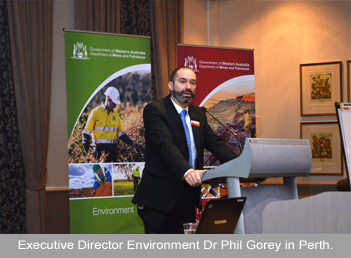 of the industry reference group joined DMP Environment Officers for a panel discussion about Mining Proposal reform at the Perth industry briefing session.
of the industry reference group joined DMP Environment Officers for a panel discussion about Mining Proposal reform at the Perth industry briefing session.
Since 2012, DMP has been developing and implementing the Reforming Environmental Regulation (RER), which is now nearing completion.
Implementation of the final reform initiatives require the Mining Legislation Amendment Bill 2015 to pass through the State Parliament. This Bill was introduced in the Legislative Assembly on 22 April 2015, and is currently awaiting debate in the Legislative Council.
The Bill consolidates all the environmental components of the Mining Act 1978 into one new part and allows for the implementation of a risk-based and outcome-focussed approach to the regulation of prospecting, mineral exploration and mining in Western Australia.
“Several components of the Bill will provide significant benefits to industry, such as the introduction of the low impact notification process and the ability to remove many environmental conditions from tenements by putting them into regulations,” Mr Sellers said.
DMP will be revising the existing regulations and will consult extensively in regard to what the regulations are intended to do. A further round of consultation will take place after the regulations have been revised and re-drafted.
MRF acknowledged for developing the economy
The 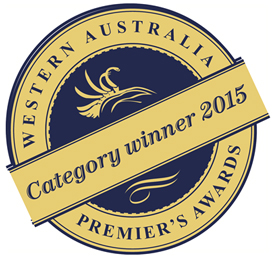 Department of Mines and Petroleum's (DMP) Mining Rehabilitation Fund (MRF) has been recognised for its contribution to economic development in Western Australia.
Department of Mines and Petroleum's (DMP) Mining Rehabilitation Fund (MRF) has been recognised for its contribution to economic development in Western Australia.
Last month the department received a Premier's Award for Excellence in Public Sector Management for the Developing the Economy category.
DMP Director General Richard Sellers said the MRF replaced the previous system of holding environmental bonds securities over tenements.
He said the new online system was a world-first which enhances the State's ongoing capacity to manage and rehabilitate abandoned mines.
Mr Sellers congratulated the efforts of DMP Environment Division staff in the work they have done to promote the MRF across the State, encouraging companies to undertake progressive rehabilitation to provide cost-effective environmental outcomes.
DMP Deputy Director General Dr Tim Griffin accepted the award on behalf of the department and said it was extremely pleasing that the department's efforts to deliver better environmental outcomes and stimulate jobs and the economy had been recognised.
"Bonds did not cover the full cost of rehabilitation, discouraged investment by tying up significant funds that could be used for developing a mining project, and could not be used to address the problem of legacy abandoned mines," he said.
The introduction of the MRF has removed the State's $4 billion potential contingent liability, injected more than $1 billion into the industry as bonds were retired, and encouraged early and ongoing rehabilitation.
There have now been two compulsory MRF reporting periods and the value of the fund will approach $60 million once the 2015 levies have been collected.
Premier Colin Barnett said the standard of all finalists in the awards was extremely high and congratulated all entrants for their innovation and creativity in the delivery of services to the Western Australian community.
"Awards programs such as these, promote the public sector as an employer of choice, promote the collaborative work of the public sector and the benefits to the WA community, and increase awareness of outstanding bodies of work recognised for excellence in public sector management," Mr Barnett said.
Further details of the finalists and winning projects is available here.
Annual Report highlights challenging times
The 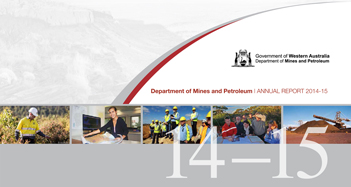 Department of Mines and Petroleum’s (DMP) Annual Report 2014-15 highlights the challenging economic conditions facing the State’s resources sector, according to Director General Richard Sellers.
Department of Mines and Petroleum’s (DMP) Annual Report 2014-15 highlights the challenging economic conditions facing the State’s resources sector, according to Director General Richard Sellers.
“The past 12 months have been particularly challenging for smaller miners operating in Western Australia,” Mr Sellers said.
“This is why the department worked with the State Government in providing assistance through the Magnetite Financial Assistance Program and the Iron Ore Financial Assistance Program.
“These programs deliver temporary assistance to small miners as they restructure their operations in challenging market conditions.”
While acknowledging the challenging economic conditions, the report also highlighted the growth which has occurred over the past decade.
“Despite the annual decline, the total value of production remained high, growing from $43.2 billion (2005-06) to $99.5 billion (2014-15) in the last 10 years, a trend that was also reflected in the total grants and royalties collected in WA,” Mr Sellers said.
“The report also showed that even with lower commodity prices, particularly iron ore, the resources sector saw $5.9 billion in royalties returned to the WA community and employment of more than 100,000 people during 2014-15.”
Mr Sellers also said the safe, sustainable and responsible management of the State’s mineral and energy resources continues to be a priority for the department.
“This is why it is so important that we have clear, consistent and transparent regulations and assessment processes that offer certainty for industry and the community around what is required to develop our mineral and energy resources.
“It is also why the department is committed to innovation in assessment processes, regulation and community education.”
The continued strengthening of safety and environmental compliance was also an important focus for 2014-15.
“The department’s recent environmental and safety reforms have increased the department’s regulatory expertise and agility,” Mr Sellers said.
“This will help ensure the department has the capacity and capability to respond to changes in the future.”
The DMP 2014-15 Annual Report is available to download from the DMP website.
Approvals Online Lodgement within Digital DMP
Department 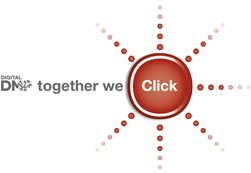 of Mines and Petroleum (DMP) Director General Richard Sellers says the Digital DMP project is progressing well with all divisions working to support the transition to online systems.
of Mines and Petroleum (DMP) Director General Richard Sellers says the Digital DMP project is progressing well with all divisions working to support the transition to online systems.
“During 2015 we have been able to move 60 per cent of transactions online and our current projections show that more than 80 per cent of our transactions will be available online by July 2016,” Mr Sellers said.
“Of course the department is committed to achieving 100 per cent of transactions online, which is something we continue to strive for.”
He said there had been a number of recent approval process improvements including increased transparency of petroleum approval process decision making.
“We have also seen the introduction of four new categories of petroleum applications in the DMP Approval Performance Report, which is now published quarterly,” Mr Sellers said.
In the September 2015 quarter, 79 per cent of Exploration Licence and 49 per cent of Prospecting Licence applications were lodged online. Overall, 66 per cent of all mineral title applications were lodged online.
In the same period 100 per cent of safety project management plans and radiation management plans were lodged online, while 76 per cent of mining environment applications and 97 per cent of petroleum environment plans were lodged online.
“Other proposed changes aim to automate the assessment of low impact notifications while maintaining high standards of environmental control,” Mr Sellers said.
Latest petroleum acreage releases announced at open day
The 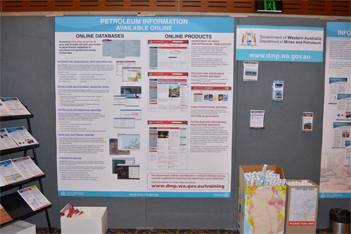 latest petroleum acreage releases for Western Australia were announced at the Department of Mines and Petroleum’s (DMP) annual Petroleum Open Day in September.
latest petroleum acreage releases for Western Australia were announced at the Department of Mines and Petroleum’s (DMP) annual Petroleum Open Day in September.
Mines and Petroleum Minister Bill Marmion announced the acreage release for areas within the onshore Canning Basin and State waters in the Northern Carnarvon Basin during his opening address.
Five blocks, one in the Canning Basin and four in the Carnarvon Basin, are available for work program bidding with a closing date of 28 April 2016.
This release and all future releases of petroleum acreage will be exclusively web-based.
The 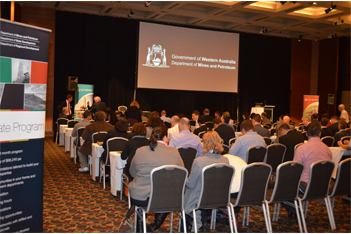 DMP website includes information on how to apply for acreage, royalties, online petroleum systems, environment and Native Title - all specific to the release areas.
DMP website includes information on how to apply for acreage, royalties, online petroleum systems, environment and Native Title - all specific to the release areas.
The department’s website also contains detailed maps of the release areas, the gazette notice, release area prospectivity summaries, data listings and land access planning considerations.
The annual open day attracted more than 280 oil and gas industry professionals to exchange information and ideas, and provided a forum for DMP’s Petroleum Division and Geological Survey of Western Australia (GSWA) to engage with government, industry and community stakeholders.
“This event provides DMP with an oppor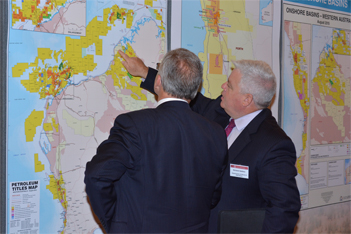 tunity to update industry on the latest developments, provide feedback to stakeholders and discuss future trends,” DMP Director General Richard Sellers said.
tunity to update industry on the latest developments, provide feedback to stakeholders and discuss future trends,” DMP Director General Richard Sellers said.
Transparency in petroleum regulation and the future of onshore petroleum in Western Australia came under the spotlight at the event, along with an industry perspective by the Australian Petroleum Production and Exploration Association (APPEA).
“Many of the presentations reflected the importance of transparency, not just for the department and the Commonwealth, but also proponents, especially in the early stages of projects,” Mr Sellers said.
“A social licence means a community has confidence in the industry and the regulator (DMP) to do the right thing.”
Some of the major presentatio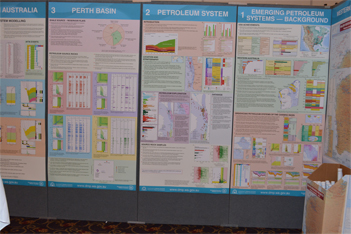 ns included:
ns included:
- Onshore petroleum: The future – Richard Sellers (Director General, DMP).
- Transparency in petroleum regulation – Jeff Haworth (Executive Director – Petroleum Division).
- Safety management / ALARP – Simon Ridge (Executive Director – Resources Safety Division).
- Environment Reforms: What we have learnt and what’s next – Phil Gorey (Executive Director – Environment Division).
- Petroleum in WA: An industry perspective – Stedman Ellis (Chief Operating Officer, WA Region, APPEA).
- New Life in the Perth Basin – Neil Tupper (General Manager, Exploration and Geoscience, AWE Ltd).
A resource management workshop was held on the day and workstations were made available for attendees to trial the department’s new online systems and provide their feedback.
management workshop was held on the day and workstations were made available for attendees to trial the department’s new online systems and provide their feedback.
A survey taken on the day by 77 attendees showed 82 per cent use DMP’s online systems, while an encouraging 86 per cent were satisfied with the level of customer service they receive from departmental staff.
Further information on the acreage release is available from the department’s website.
2014-15 Statistics Digest highlights challenges faced by resources sector
The value 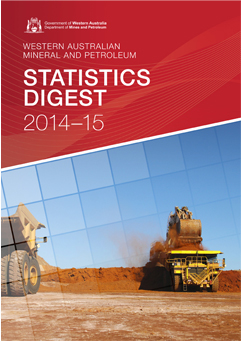 of Western Australia’s mineral and petroleum industry in 2014/15 was $99.5 billion - a fall of 19 per cent from the record $122 billion in 2013/14.
of Western Australia’s mineral and petroleum industry in 2014/15 was $99.5 billion - a fall of 19 per cent from the record $122 billion in 2013/14.
A weakening Australian dollar, which averaged 83.6 cents for the period, helped to offset falling commodity prices to some extent, partially shielding producers from lower prices across many commodities.
DMP Director General Richard Sellers said that despite the drop in the industry’s value last financial year, Western Australia’s industry value has followed a predominately positive trend since 1995.
“There is no doubt that 2014/15 presented a challenging year for many in Western Australia’s mineral and petroleum industry,” Mr Sellers said.
“The industry’s value for the financial year 2014/15 is an increase of almost 300 per cent compared to 10 years ago and 700 per cent compared to 20 years ago and is currently similar to values seen in the 2011/12 and 212/13 financial years,” Mr Sellers said
The weaker price of iron ore over the period was the main driver behind the sector’s overall decrease in value in 2014/15.
While Western Australia increased iron ore production by 15 per cent, the lower than expected iron ore price resulted in a 27 per cent decrease in the value of sales for the period.
Despite the drop in the value of sales, iron ore remained the State’s highest value commodity, accounting for $54 billion and 71 per cent of total mineral sales during 2014/15.
The value of petroleum products produced in State areas (onshore and offshore) and in adjacent Commonwealth offshore areas amounted to $24 billion in 2014/15, a 9 per cent decrease on the previous year.
The petroleum sector’s value was adversely affected by declining crude oil prices, which averaged US$85 per barrel for the first half of the financial year before falling to an average of US$53 per barrel during the second half.
The most valuable petroleum product was LNG, which marginally increased output to reach a record 20.4 million tonnes.
Price affected the overall value of LNG sales, which decreased by 4 per cent from the previous year to $13.8 billion.
LNG production is forecast to grow in the period ahead with supply from new projects coming on stream, including Gorgon and Wheatstone.
As at September 2015, Western Australia has an estimated $171 billion worth of resource projects under construction, or in the committed stage of development.
A further $110 billion is identified as planned or possible projects.
However, Mr Sellers said these investment statistics need to be interpreted with caution as the outlook for major projects will decline sharply during the next 18 months as several major, and high value, projects are completed.
“While the value of resource investment will drop over this period, it means these projects will move into production and contribute to the State’s economic growth through increased production values, exports and royalty revenue,” Mr Sellers said.
It is estimated that by 2020, the total value of production added by newly completed projects will be just over $50 billion. This could translate to an additional $1.3 billion in royalty revenue by 2020.
The latest Statistics Digest is available now on the DMP website.
DMP recognised for State contribution
The Department of Mines and Petroleum (DMP) has been awarded a Certificate of Appreciation for creating meaningful employment opportunities for people with a disability.
DMP Director General Richard Sellers congratulated Facilities Services staff for delivering great results for people with a disability in Western Australia.
“This award comes just a month after DMP announced its second contract to Western Australian Disability Enterprises (WADE),” Mr Sellers said.
“DMP is committed to providing meaningful employment opportunities for people with disabilities.”
The department’s WADE contracts now include cleaning and the maintenance of gardens and grounds at Mineral House and Carlisle.
Currently the State Government has achieved $25 million in State and local government contract arrangements with WADE across a range of products and services.
This achievement signifies a great accomplishment towards achieving the goal of $50 million in new business and providing 2,500 valued jobs by 2018.
You can learn more about WADE on its new website.
Golden Gecko Awards
The 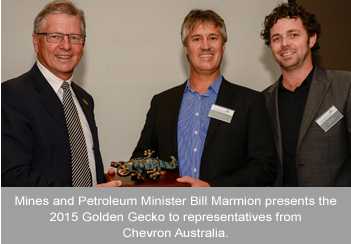 Department of Mines and Petroleum’s (DMP) prestigious Golden Gecko Awards for Environmental Excellence was presented to Chevron Australia in October for an innovative and environmentally sensitive solution to a pipeline shore crossing.
Department of Mines and Petroleum’s (DMP) prestigious Golden Gecko Awards for Environmental Excellence was presented to Chevron Australia in October for an innovative and environmentally sensitive solution to a pipeline shore crossing.
Mines and Petroleum Minister Bill Marmion presented Chevron with the 2015 Golden Gecko Award for the project, a 1.2 kilometre-long micro-tunnel linking a 225 kilometre gas pipeline to the onshore processing facilities at Chevron’s Wheatstone natural gas project.
DMP Director General Richard Sellers praised Chevron Australia’s commitment to upholding high environmental standards, while developing a solution for the shore crossing.
“It is pleasing the department can formally recognise resources projects such as this that go above and beyond regulatory requirements and show true environmental innovation and excellence,” he said.
Chevron’s Wheatstone development is located adjacent to the Ashburton River Delta, which supports important mangrove and estuarine habitats.
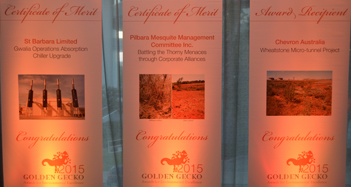 Community engagement undertaken by Chevron also showed that the shoreline was highly valued by the local Onslow community.
Community engagement undertaken by Chevron also showed that the shoreline was highly valued by the local Onslow community.
“Chevron investigated five options for a shore crossing and chose the one with the lowest environmental impact, even though it was the most expensive choice,” Mr Sellers said.
Monitoring undertaken on the Ashburton River Delta since the micro-tunnel was drilled has shown excellent environmental outcomes with no ground disturbance and an increase in the number of mature mangrove trees adjacent to the tunnel corridor.
Certificates of Merit were also presented to Pilbara Mesquite Management Committee for spearheading a resources company alliance to manage weed control across the Pilbara, and St Barbara Ltd for more than doubling the cooling capacity of the Gwalia underground mine by converting waste heat energy from the power plant to cool air.
2015 Golden Gecko Awards for Environmental Excellence
Golden Gecko Award:
- Chevron Australia – Wheatstone Micro-tunnel project
Certificate of Merit:
- Pilbara Mesquite Management Committee Inc – Battling the Thorny Menaces through Corporate Alliances
- St Barbara Limited – Gwalia Operations Absorption Chiller Upgrade
Finalists:
- Fortescue Metals Group Limited / Ziltek Pty Ltd / PT Environmental Services – Better Outcomes from Hydrocarbon Spills using RemScanTM
- Kalgoorlie Consolidated Gold Mines – Gidji Emissions Reduction Project
- Pilbara Ports Authority – Mangrove Rehabilitation Program
- Premier Coal / Golder Associates – Lake Kepwari Trial Flow-through
- Rio Tinto Iron Ore Utilities Division – West Angelas Fuel Hub
Information about the awards is available from the DMP website.
Inspections target dangerous goods sites
Regional 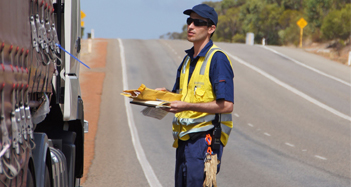 visits to Geraldton, Toodyay, Shark Bay, Port Hedland and Newman during the last few months has been a part of the Department of Mines and Petroleum (DMP) Dangerous Goods Safety Branch inspection program.
visits to Geraldton, Toodyay, Shark Bay, Port Hedland and Newman during the last few months has been a part of the Department of Mines and Petroleum (DMP) Dangerous Goods Safety Branch inspection program.
DMP Director General Richard Sellers said the inspection program aimed to assist and educate operators to ensure the risks posed from dangerous goods to the community are minimised.
He said dangerous goods without proper safety equipment, placarding and paperwork increases the risks for the public and the emergency services.
“Companies storing dangerous goods without appropriate fire control equipment can receive penalties of up to $50,000 for every piece of fire equipment missing or out of date,” Mr Sellers said.
“The majority of dangerous goods operators have high safety standards, but we will continue to target companies and individuals that are not compliant and put people at risk.”
The department will also focus on operators that don’t have at least a three metre firebreak around dangerous goods storage areas.
On the spot fines of $2500 can be issued to operators who don’t ensure the firebreak is kept clear of combustible material.
The department has about 20 dangerous goods officers responsible for education and enforcement.
More information is available from the department’s website for dangerous goods safety.
Mines Safety Roadshow travels the State
Risks 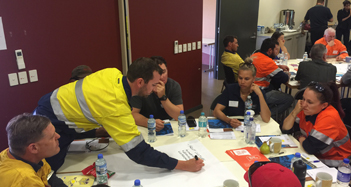 associated with height were the focus of the Department of Mines and Petroleum’s (DMP) 2015 Mines Safety Roadshow which traveled throughout the State last month.
associated with height were the focus of the Department of Mines and Petroleum’s (DMP) 2015 Mines Safety Roadshow which traveled throughout the State last month.
DMP Director General Richard Sellers said the annual roadshow visited Newman, Karratha, Port Hedland, Bunbury, Kalgoorlie, Mandurah and Perth.
“This is the eleventh annual Mines Safety Roadshow and is presented by DMP’s Resources Safety Division to highlight important safety issues in Western Australia’s mining industry,” Mr Sellers said.
The 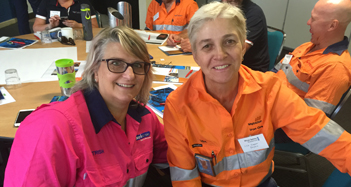 roadshows are one of the department’s most important proactive events for the mines inspectorate.
roadshows are one of the department’s most important proactive events for the mines inspectorate.
“The free event attracts safety and health representatives, supervisors and others responsible for safety and health in the State’s resources industry, and provides an update on what is happening in these two vital areas,” Mr Sellers said.
He said this year’s program also showcased two new hazard videos on the consequences of falling from height.
Other topics covered included working at height, rock falls, fall of ground, and risks and controls.
The 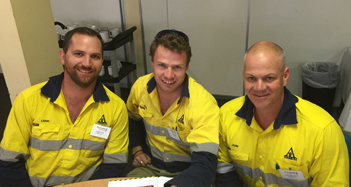 roadshow also looked at the results of the serious injuries review that was recently completed by the department.
roadshow also looked at the results of the serious injuries review that was recently completed by the department.
The roadshow is an interactive event encouraging participation and the exchange of ideas, and participants are given the chance to network with other safety personnel and departmental staff.
Report helps unravel safety risks in mining
Department 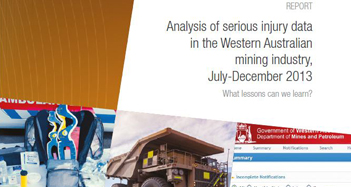 of Mines and Petroleum (DMP) Director General Richard Sellers has commended a recently released report, which he said will improve our understanding about what causes serious accidents.
of Mines and Petroleum (DMP) Director General Richard Sellers has commended a recently released report, which he said will improve our understanding about what causes serious accidents.
“The analysis of more than six hundred serious mining injuries will improve our understanding of injury risks and causes in Western Australia’s mining industry,” Mr Sellers said.
“The report will not only help increase our understanding about what causes serious accidents, but also how we can prevent them having fatal outcomes.”
The department analysed 658 serious injuries, including three fatalities, reported by the mining industry during a six month period from 1 July to 31 December 2013.
The analysis follows on from the department’s review of 52 fatal accidents in the mining industry between 2000 and 2012.
The key objective of both these reports was to develop a better understanding of the injury risk profile of the State’s mining industry.
Mr Sellers said risk profiles had been compared to establish if the hazards and causation factors identified from the recent serious injury data are consistent with the results of the fatal accident review.
Both the serious injury review and the fatal accident review have independently identified the three main hazards for all employees - falling while working at height, being in the line of fire of objects or suspended loads and being struck or crushed by machines and heavy components.
Selected serious injury data was shown to be statistically consistent over a period of 10 years and will be used to establish baseline standards for monitoring the effectiveness of fatality prevention strategies.
Mr Sellers said the department was encouraging companies to build on the information available and develop more comprehensive hazard and risk profiles. He also said that that job and task analysis should focus attention on critical tasks and activities where risks are heightened.
DMP has been sharing the results of the reviews with key representative groups in Perth and regional centres.
Presentations were also made at Nifty, Woodie Woodie and Telfer - the three mine sites in the Pilbara where fatal accidents have occurred this year.
“The analysis is also published on the department’s website, and hard copies will be posted to all registered mine managers and safety and health managers and representatives,” Mr Sellers said.
Copies of the report were also distributed during DMP’s Mines Safety Roadshow and through the department’s regional offices.
There have been on average two to three deaths a year on WA mine sites, however, this report identifies that there are on average approximately 200 high consequence injuries every 12 months which have very similar causal factors to fatalities.
“By the department reviewing the rate of high severity injuries including amputations, fractures and crush injuries, we are hoping to find key indicators so more efforts can be focused on critical activities which have been shown can link to serious injuries or fatalities,” Mr Sellers said.
The report is available to download on the department’s website.
Successful year for Reconciliation Action Plan Committee
It has  been a busy year for the Department of Mines and Petroleum’s (DMP) Reconciliation Action Plan (RAP) Committee with a number of successful initiatives being implemented.
been a busy year for the Department of Mines and Petroleum’s (DMP) Reconciliation Action Plan (RAP) Committee with a number of successful initiatives being implemented.
“With the year coming to a close, the RAP Committee is putting the final touches on the Reconciliation Action Plan for 2016-2018 to seek final endorsement from Reconciliation Australia,” DMP Director General Richard Sellers said.
He said the committee was looking to launch the new RAP in early 2016 and was also looking to expand its current membership.
The RAP Committee is currently chaired by Phil Gorey, Executive Director Environment and comprises Aboriginal and non-Aboriginal members from within the department and externally.
The committee 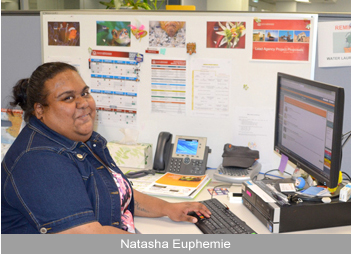 meets once a quarter to discuss new initiatives and track the implementation of the department’s RAP.
meets once a quarter to discuss new initiatives and track the implementation of the department’s RAP.
Amanda Kickett, Natasha Euphemie and Shaynee Donovan are all members of the RAP Committee and, at one time or another, have been involved in the Aboriginal Employment Strategy. They share some of the reasons they enjoy participating in the committee:
Interacting with people I never usually speak to and valuing the varying opinions they have. – Amanda Kickett, Senior Title Services Officer
I get to have a say and have options as an Aboriginal worker. – Natasha Euphemie, Administrative Assistant
I get to contribute to building k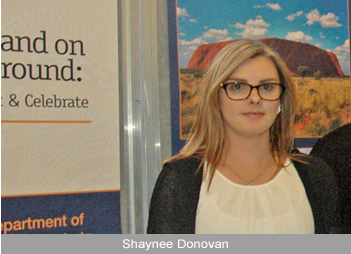 nowledge and understanding of Aboriginal culture within the workplace and also contribute ideas to Aboriginal events. - Shaynee Donovan, Administrative Assistant
nowledge and understanding of Aboriginal culture within the workplace and also contribute ideas to Aboriginal events. - Shaynee Donovan, Administrative Assistant
The RAP Committee works together with employees from across the department to enhance respect, relationships and opportunities between Aboriginal and non-Aboriginal people to establish a solid foundation for ongoing reconciliation.
In addition to the launch of the RAP, the committee is currently preparing for the launch of its Aboriginal Employment Strategy for 2016 and the rolling out of its one-day cultural awareness training for employees.